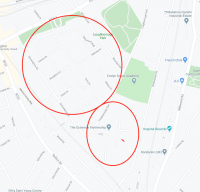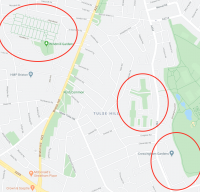newbie
undisambiguated
yehIt isn't, but it's one of the generic smears that certain people drop in as an accusation when they've can't argue on evidence. Just call it oppression of the working class or gentrification and you'll probably get away with it. If somethings going to make the area better and you want to argue against it - gentrification. Bloody gentrifiers, choosing to live their lives in an area and wanting to make it better, pulling up the drawbridge. Pah - keep it shit.
In turn -
- Permeability is improved for people walking and cycling whilst intentionally restricted for those driving to discourage car use. Evidence from overseas (Netherlands), and London (Waltham Forest) is that this is effective and the benefits outweigh the disbenefits. Traffic drops and air quality improves overall.
- Resilience. Assuming you don't want to maximise capacity and make every minor road busy I assume your idea is that that the minor roads create a pressure relief valve and give traffic somewhere to go if a main road is blocked. this just doesn't work as the capacity of the back streets is far less than the main roads so they whole area just rapidly gridlocks anyway. This happened when Brixton Hill was blocked because a speeding driver had crashed into a bus at 5am on a Sunday morning a few years back. All the roads to either side of Brixton Hill blocked up with drivers trying to find their way around and with drivers behaving like arseholes there was a serious hit and run on a child on New Park Road.
- Bus Journey Times. Usually they improve. Cutting the volumes turning off main roads into side roads actually makes the main roads run more smoothly - there are fewer collisions and less instances of buses being held up by turning traffic. The bus on Railton/Atlantic Road will run a lot better when the other traffic is cut
- Local peoples access. Every house is still accessible by car. Some trips, in some directions, will take a bit longer but maybe they'll be made in another way. (cross ref with household car ownership/income etc).
I get what you're saying about bus journey times. I hope you're right. I simply doubt it.
I'll pick up on resilience, because I've been hoping someone would address it.
You're right, the backstreets clog when the arteries seize, but it's still instructive to consider how it works. An unexpected blockage on Acre Lane by Lidl, for example. Doesn't matter what, collision, burst water main, whatever. Traffic can easily divert to Brixton Hill via Branksome and Lambert Roads. It's messy, it's slow, it clearly doesn't replace the main road, but it helps.
A blockage in a similar place on Brixton Hill has no available redundant route, except way up the hill there's the long way round via Kings Avenue.
That's an outcome, intended or otherwise of a previous creation of a relatively impervious area. As planned there was a gate outside the church on Lambert Road, but someone took an angle grinder to it a couple of times and the council gave up. Interestingly people from within the impervious heart complain about traffic almost as much as those elsewhere campaigning for their street become one. Human nature I guess.
Reducing the resilience, by gating the AL to BH through route as has been demanded on the consultation, will help how? All the pressure will be on Kings Avenue. < anecdata: During lockdown I walked along there. There were some little kids playing in the tiny front yard of a flat, separated from the pavement/road by a low wall topped by a bit of what looked like bamboo beach mat. I've never noticed them when the traffic was normal.>. A consequence of the demand to reduce permeability here is refelected elsewhere, on someone else.
If, as planned the other side of Brixton Hill is also closed to through traffic, the unplanned blockage pressure can only be relieved by Water Lane and the S Circular. Same with Ferndale.
I see nobody winning in this except those who live inside the impervious areas, but then my explicit aim is not to force people to behave the way I tell them to by a mixture of frustration and alienation.



